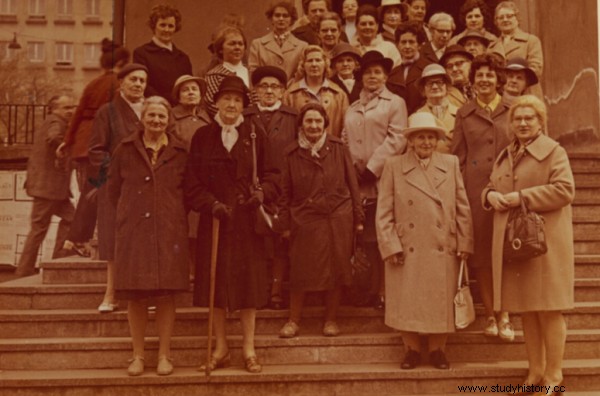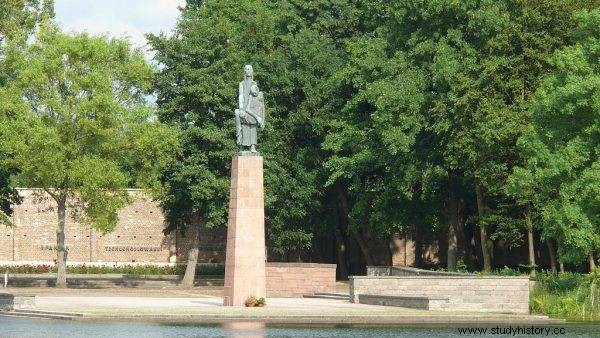Terror, exploitation and genocide reigned in this camp. The authorities tried to set up a self-propelling hate machine in which prisoners of different nationalities would oppress each other under the supervision of German guards. What the torturers did not foresee was the steadfast spirit of Polish girl scouts who at all costs kept their humanity where there was almost no hope.
“If two people are not talking to each other, they start shooting. War degrades people, returns them to the beginning of the development of civilization. " These words of General Robert Baden-Powell perfectly illustrate the cruelty of war, and with it the bestiality and dehumanization of concentration camps. The one in Ravensbrück has become a symbol of women's hell. It was the only completely female camp in Germany. Established in 1939, with time it became a distribution point for female prisoners transported here from other places.
Organization of Hell
The first women to come here were women from Silesia, Pomerania, Lubusz Land and East Prussia. With time, more prisoners were brought from the area of occupied Poland. Transports were systematically increased.
It is estimated that over 130,000 people were imprisoned in Ravensbrück throughout the entire operation of the camp. women. Polish, Russian, French, Dutch, British, German, Jewish, Roma and many others - a total of 27 different nationalities, whose representatives at all costs tried to argue with each other, humiliate them and take away their humanity . About 92,000 died in the camp. women. Out of 40 thousand Only 8,000 Polish women survived.

Thanks to the girl scouts who helped their fellow inmates, the chances of surviving the torment increased. In the picture. members of the Club of Former Prisoners of the Ravensbrück Concentration Camp in Krakow.
After being brought to the camp, the women were given a number and were handed badges, which they then had to sew to the received outfit. Black color is intended for "anti-social" - prostitutes, petty thieves, lesbians. Green for professional criminals, red for political prisoners, purple for Bible Students, yellow for Jewish women.
Zugangs for drill
Then the prisoners were led to the bathhouse, their heads were shaved and they were subjected to medical examination, including a very painful gynecological examination. For fear of diseases, the newly arrived women were sent to a 3-week quarantine, which was often extended.
It was used to prepare inmates for camp life. During its duration, women learned about the strict discipline and regime that were intended to intimidate them and arouse a constant sense of threat. As we read in the book by Anna Maria Kwiatkowska-Bied "Harcerki z Ravensbrück":
They called them [sense of threat and fear, note by A.J] not only the brutality of the caretakers and block members, but also the hostility of other prisoners and their insensitivity to others. Loneliness - this feeling was constantly nurtured in prisoners .

The text was created, among others based on the book by Anna Kwiatkowska-Bieda "Harcerki z Ravensbrück", which has just been published by the Bellona publishing house.
Soon, the newcomers were to learn the rules of camp life and see how much the camp authorities were doing to attack one group of prisoners, arouse resentment and hatred. The very living conditions, physical fatigue and hunger were supposed to encourage the prisoners to look at each other like a wolf. In such conditions, a network of informers was built, which greatly facilitated the elimination of rebellious women.
Despite the enormous efforts of the camp authorities, despite the terror and ubiquitous death in Ravensbrück, the prisoners resisted. They created a conspiratorial scout team, bringing help, a good word and hope for a better tomorrow, for a return home.
A ray of hope
When Józefa Kantor (pseudonym Ziuta) was brought to the camp, she realized very quickly that the quarantine was supposed to kill hope and stupefy the inmates. So she began to think to escape this cruel reality. “Only thoughts run uncontrolled and free. So I thought. " - we read in the book "Harcerki z Ravensbrück". - "But I can't be passive to what is happening around me."

Obelisk commemorating female prisoners of Ravensbrück
Ziuta was well aware that her companions of misery, just like her, felt the hopelessness and terror that were sown in them. She devised a plan that could cheer them all up. Since conversations were forbidden, after the siren that announced the curfew, Joseph began a prayer in a whisper. More whispers quickly joined her, uniting into a common voice. The prisoners were severely punished for this. However, as Anna Maria Kwiatkowska-Bieda writes, they achieved a moral victory that day:
After this incident, we would say our prayers in a whisper that no one could hear. In my opinion, these collective prayers were the beginning of a common, spiritual resistance, its first form, and they constituted one of the most important elements of our future camp community - recalls that event Stanisława Schönemann-Łuniewska from Chorzów, who was sent to the camp for her activity in the ZWZ.
It wasn't long before the idea of creating a scout team was born in the minds of the Polish women inmates, which was to bring help and hope to others.
"Walls"
The Girl Scouts recognized themselves in the gloomy reality of the Ravensbrück camp through their attitude from the ranks of pre-war organizations. They passed on secret messages, organized the members, until one day Józefa Kantor received the message:"We are ready, we are waiting for the fundraiser".
The first scouting meeting took place after the evening roll-call on the third - third level of bunk beds, right under the ceiling. It was hard for exhausted scouts to climb, but it was the safest place. Extremely high, stuffy and uncomfortable, but it was these bunks that were controlled least often by the guards, who simply did not want to strain.

The girl scouts tried to alleviate the suffering of women on whom Nazi doctors conducted their murderous experiments
The team took the name "Walls". Because although the walls surrounded her members and separated them from the world, from home, they were a symbol of protection and security for them.
Earlier, the teammates with their bridesmaids talked about the most important features for a girl scout in camp conditions. “She must be strong, unbending, persistent in working for others, resistant to hardships. Cohesive like the walls from which magnificent edifices are made, soaring upwards ", the bridesmaid Józef Kantor recalled those findings.
And this is what the members of the underground Ravensbrück army were like. They helped the weaker every day, carried burdens for older prisoners, stole food and clothes and distributed them among the inmates . They sang scout songs, gave lectures, acquired and passed on valuable information from behind the camp walls, and relieved the suffering of women undergoing inhuman medical tests.
All this at the risk of your own life. In constant fear and fear of being caught. Conscious of the cruel punishments that awaited them in the event of a mishap. Unbending, steadfast, extremely devoted to the cause. It is thanks to them that many of the women imprisoned in Ravensbrück survived.
"The easiest way to avoid war is by instilling in young people a love of peace, not letting the contradictions resulting from differences in race, religion, nationality and property sprout among them," said Robert Baden-Powell. Polish girl scouts who grew up on these principles brought help and hope. Their stories are told in the book by Anna Maria Kwiatkowska-Bied "Harcerki z Ravensbrück".
Literature:
- W. Kiedrzyńska, "Ravensbrück female concentration camp", Warsaw 2019.
- A.M. Kwiatkowska-Bieda, "Scouts from Ravensbrück", Ożarów Mazowiecki 2021.
- Z. Stanuch, "Golgotha of women. Accounts of female prisoners of Ravensbrück and other concentration camps from the collections
- Polish Source Institute in Lund ”. Szczecin 2018.
